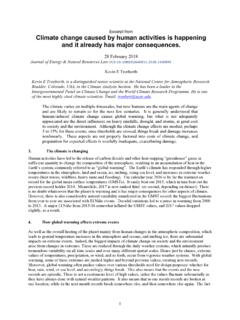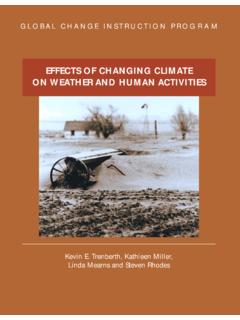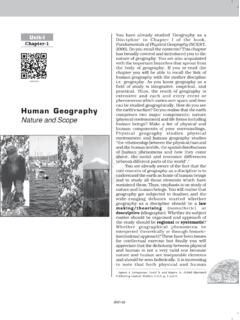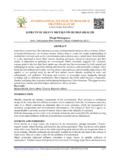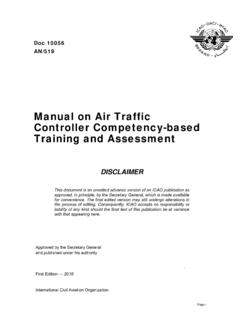Transcription of Effects Of Changing Climate On Weather And Human ...
1 GLOBAL CHANGE INSTRUCTION PROG R A M. Effects OF Changing Climate . ON Weather AND Human ACTIVITIES. Kevin E. Trenberth, Kathleen Miller, Linda Mearns and Steven Rhodes Effects OF. Changing Climate . ON Weather . AND Human ACTIVITIES. Effects OF. Changing Climate . ON Weather . AND Human ACTIVITIES. Kevin E. Trenberth, Kathleen Miller, Linda Mearns and Steven Rhodes National Center for Atmospheric Research Boulder, Colorado UNIVERSITY SCIENCE BOOKS. SAUSALITO, CALIFORNIA. University Science Books 55D Gate Five Road Sausalito, CA 94965. Fax: (415) 332-5393. Scientific director: Tom Wigley Managing editor: Lucy Warner Editor: Carol Rasmussen Art and design: NCAR Image and Design Services Cover design and composition: Craig Malone Cover photo by Mickey Glantz The cover photograph of the Effects of drought on a farm in eastern Colorado in 1977 is prototypical of scenes in the 1930s during the dust bowl era. The risk of such droughts with global warming increases owing to increased drying of the landscape.
2 This book is printed on acid-free paper. Copyright 2000 by University Corporation for Atmospheric Research. All rights reserved Reproduction or translation of any part of this work beyond that permitted by Section 107 or 108 of the 1976 United States Copyright Act without the permission of the copyright owner is unlawful. Requests for permission or further information should be addressed to UCAR. Communications, Box 3000, Boulder, CO 80307-3000. Library of Congress Cataloging-in-Publication Data Effects of Changing Climate on Weather and Human activities / Kevin Trenberth .. [et al.]. p. cm. (The global change instruction program). Includes bibliographical references and index. ISBN 1-891389-14-9 (softcover : alk. paper). 1. Climatic changes. 2. Weather . 3. Human beings Effect of Climate on. I. Trenberth, Kevin E. II. Series. E44 2000. '5 dc21. 00-023978. Printed in the United State of America 10 9 8 7 6 5 4 3 2 1. A Note on the Global Change Instruction Program This series has been designed by college professors to fill an urgent need for interdisciplinary materials on global change.
3 These materials are aimed at undergraduate students not majoring in science. The modular materials can be integrated into a number of existing courses in earth sciences, biology, physics, astronomy, chemistry, meteorology, and the social sciences. They are written to capture the interest of the student who has little grounding in math and the technical aspects of science but whose intellectual curiosity is piqued by concern for the environment. For a complete list of modules available in the Global Change Instruc- tion Program, contact University Science Books, Sausalito, California, Information is also available on the World Wide Web at http:// or V. Contents Preface ix Introduction 1. I. Climate 4. The Climate System 4. The Driving Forces of Climate 6. The Spatial Structure of Climate 7. II. The Weather Machine 9. III. Climate Change 14. Human -Caused Climate Change 14. The Enhanced Greenhouse Effect 14. Effects of Aerosols 15.
4 The Climate Response and Feedbacks 15. IV. Observed Weather and Climate Change 17. Observed Climate Variations 17. Interannual Variability 19. V. Prediction and Modeling of Climate Change 21. Climate Models 21. Climate Predictions 21. Interpretation of Climate Change in Terms of Weather 23. VI. Impacts of Weather and Climate Changes on Human Activities 25. Weather Sequences 25. Location, Location, Location 25. Severe Weather Events 26. Societal Responses 26. Managing Risk 27. Impacts on Agriculture 27. Planning for Local Weather Changes 31. VII. The Need for More Research 33. Glossary 34. Suggested Readings 38. Discussion Questions 39. Index 40. Preface It is now widely recognized that Human activities are transforming the global environment. In the time it has taken for this book to come to fruition and be published, the evidence for Climate change and its disruption of societal activi- ties has become stronger. In the first 11 months of 1998, there were major floods in China, Peru, and California, enormous damage from Hurricane Mitch in Central America, record-breaking heat waves in Texas, and extensive drought and fires in Indonesia; Weather -related property losses were estimated at over $89 billion, tens of thousands of lives were lost, and hundreds of thousands of people were displaced.
5 This greatly exceeds damage estimates for any other year. The environment was ravaged in many parts of the globe. Many of these losses were caused by weird Weather associated with the biggest El Ni o on record in 1997 98, and they were probably exacerbated by global warming: the Human -induced Climate change arising from increasing carbon dioxide and other heat-trapping gasses in the atmosphere. The Climate is Changing , and Human activities are now part of the cause. But how does a Climate change manifest itself in day-to-day Weather ? This book approaches the topic by explaining distinctions between Weather and Climate and how the rich natural variety of Weather phenomena can be sys- tematically influenced by Climate . Appreciating how the atmosphere, where the Weather occurs, interacts with the oceans, the land surface and its vegetation, and land and sea ice within the Climate system is a key to understanding how influences external to this system can cause change.
6 One of those influences is the effect of Human activities, especially those that change the atmospheric com- position with long-lived greenhouse gases. Climate fluctuates naturally on very long time scales (thousands of years), and it is the rapidity of the projected changes that are a major source of concern. The possible impacts of the projected changes and how society has responded in the past and can in the future are also described. Everyone will be affected one way or another. So this is an important topic, yet it is one about which a certain amount of disinformation exists. Therefore it is as well to understand the issues in Climate change and how these may affect each and every one of us. What we should do about the threats, given the uncertainties, is very much a choice that depends upon values, such as how much we should be stewards for the planet and its finite resources for the future generations. Many people favor a precautionary principle, better safe than sorry, and err on the side of taking actions to prevent a problem that might not be as bad as feared.
7 This book helps provide the knowledge and enlightenment desirable to ensure that the debate about this can be a public one and carried out by people who are well informed. Kevin E Trenberth IX. Acknowledgments This instructional module has been produced by the Global Change Instruction Program of the University Corporation for Atmospheric Research, with support from the National Science Foundation. Any opinions, findings, conclusions, or recommendations expressed in this publication are those of the authors and do not necessarily reflect the views of the National Science Foundation. This project was supported, in part, by the National Science Foundation Opinions expressed are those of the authors and not necessarily those of the Foundation Introduction We experience Weather every day in all its won- tion was wrong, major economic losses occurred derful variety. Most of the time it is familiar, yet in both years and lives were disrupted.
8 It never repeats exactly. We also experience the These Weather patterns and kinds of Weather Changing seasons and associated changes in the constitute a short-term Climate variation or fluc- kinds of Weather . In summer, fine sunny days tuation. If they repeat or persist over prolonged are interrupted by outbreaks of thunderstorms, periods, then they become a Climate change. For which can be violent. Outside the tropics, as instance, in parts of the Sahara Desert we now winter approaches the days get shorter, it gets expect hot and dry conditions, unsuitable for colder, and the Weather typically fluctuates from Human habitation, where we know that civiliza- warm, fine spells to cooler and snowy condi- tions once flourished thousands of years ago. tions. These seasonal changes are the largest This is an example of a Climate change. changes we experience at any given location. How has the Climate changed? What are the Because they arise in a well-understood way factors contributing to Climate and therefore to from the regular orbit of the Earth around the possible change?
9 How might Climate change in Sun, we expect them, we plan for them, and we the future? How does a change in Climate alter even look forward to them. We readily and will- the Weather that we actually experience? How ingly plan (and possibly adapt) summer swim- much certainty can we attach to any predic- ming outings or winter ski trips. Farmers plan tions? What do we do in the absence of pre- their crops and harvests around their expecta- dictability? Why are Climate change and associ- tion of the seasonal cycle. ated Weather events important? What are the By comparison with this cycle, variations in likely impacts on Human endeavors and society the average Weather from one year to the next and on natural-resource-based economic activi- are quite modest, as they are over decades or ties, such as agriculture? These are some of the Human lifetimes. Nevertheless, these variations questions we address in this module. Our dis- can be very disruptive and expensive if we do cussion of impacts will focus on Human activi- not expect them and plan for them.
10 For exam- ties. Although very important, the impacts of ple, in summer in the central United States, the Climate change on the natural environment and major drought in 1988 and the extensive heavy the unmanaged biosphere are not dealt with rainfalls and flooding in 1993 were at the here. Some of these consequences are discussed extremes for summer Weather in this region. (In further in the Global Change Instruction Pro- the upper Mississippi Basin, rainfalls in May, gram module Biological Consequences of Global June, and July changed from about 150 millime- Climate Change. ters in 1988 to over 500 mm in 1993.) These two Many of these questions, although of con- very different summers were the result of very siderable importance, unfortunately do not have different Weather patterns. We assumed, before simple answers. Also, many of the answers are their occurrence, that the usual summertime not very satisfying. Because of the nature of the mix of rain and sun would occur and that farm- phenomena involved, many outcomes can only ers' crops would flourish.
